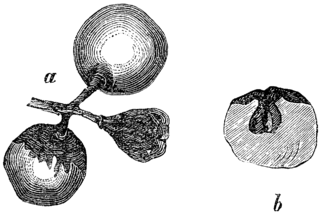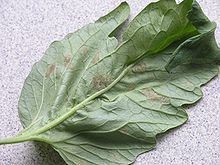
Botrytis cinerea is a necrotrophic fungus that affects many plant species, although its most notable hosts may be wine grapes. In viticulture, it is commonly known as "botrytis bunch rot"; in horticulture, it is usually called "grey mould" or "gray mold".

Phytoalexins are antimicrobial substances, some of which are antioxidative as well. They are defined, not by their having any particular chemical structure or character, but by the fact that they are defensively synthesized de novo by plants that produce the compounds rapidly at sites of pathogen infection. In general phytoalexins are broad spectrum inhibitors; they are chemically diverse, and different chemical classes of compounds are characteristic of particular plant taxa. Phytoalexins tend to fall into several chemical classes, including terpenoids, glycosteroids, and alkaloids; however the term applies to any phytochemicals that are induced by microbial infection.

The Pathogen-Host Interactions database (PHI-base) is a biological database that contains manually curated information on genes experimentally proven to affect the outcome of pathogen-host interactions. The database has been maintained by researchers at Rothamsted Research and external collaborators since 2005. PHI-base has been part of the UK node of ELIXIR, the European life-science infrastructure for biological information, since 2016.
Pseudomonas parafulva is a Gram-negative bacteria. It is epiphytic and has been demonstrated to antagonise the fungal plant pathogen Botrytis cinerea.
Alternaria raphani is a fungal plant pathogen.

Phaeoramularia dissiliens is a fungal plant pathogen which causes cercospora leaf spot on grapes.
Pseudocercospora purpurea is a fungal plant pathogen that causes a leaf spot on the avocado. Species Cercospora purpurea was originally found on the leaves of Persea species in Georgia, USA in 1878. before the species was transferred to the Pseudocercospora genus in 1976.

Phoma destructiva is a fungal plant pathogen infecting tomatoes and potatoes.
Cladosporium musae is a fungal plant pathogen that causes Cladosporium speckle on banana and which occurs in most countries in which the fruit is cultivated. Unsuccessful attempts to transfer the Cladosporium pathogen in vitro to healthy banana plants seem to confirm reports that the infection remains latent in otherwise healthy plants.

Apiognomonia errabunda is a fungal plant pathogen and causal agent of oak anthracnose. It is one of the most widespread leaf-associated fungi in the northern temperate zone and is found mostly on oak, beech, and linden trees.
Pathogenic fungi are fungi that cause disease in humans or other organisms. Although fungi are eukaryotic, many pathogenic fungi are microorganisms. Approximately 300 fungi are known to be pathogenic to humans; their study is called "medical mycology". Fungal infections kill more people than either tuberculosis or malaria—about 2 million people per year.

A fungus is any member of the group of eukaryotic organisms that includes microorganisms such as yeasts and molds, as well as the more familiar mushrooms. These organisms are classified as one of the traditional eukaryotic kingdoms, along with Animalia, Plantae and either Protista or Protozoa and Chromista.

Plant disease resistance protects plants from pathogens in two ways: by pre-formed structures and chemicals, and by infection-induced responses of the immune system. Relative to a susceptible plant, disease resistance is the reduction of pathogen growth on or in the plant, while the term disease tolerance describes plants that exhibit little disease damage despite substantial pathogen levels. Disease outcome is determined by the three-way interaction of the pathogen, the plant and the environmental conditions.
Polygalacturonase inhibitor proteins (PGIPs), also known as polygalacturonase-inhibiting proteins, are plant proteins capable of inhibiting the action of polygalacturonase (PG) enzymes produced by bacterial and fungal pathogens. PGs can be produced by pathogens to degrade the polygalacturonan component of plant cell walls. PGIPs are leucine-rich repeat glycoproteins of approximately 360 amino acids in length, and PGIPs may reduce the activity of PGs by one or two orders of magnitude. Both competitive and non-competitive inhibition has been observed for various PGIPs. However, no inhibition of endogenous plant PGs that participate in fruit ripening by PGIPs have been reported.
Serendipita indica is a fungal species of the order Sebacinales. It is an endophytic root-colonising species, discovered from orchid plants in the Thar desert in Rajasthan, India by Prof. Ajit Verma and group, School of Life Sciences, Jawaharlal Nehru University, New Delhi. The fungus has typical pear-shaped chlamydospores. S. indica can be easily grown on various substrates. It has been found to promote plant growth during its mutualistic symbiotic relationship with a wide variety of plants. Experiments have shown that S. indica increases the resistance of colonized plants against fungal pathogens. It has also been found in experiments with barley that S. indica-inoculated plants are tolerant to salt stress and more resistant to root pathogens. S. indica-infested roots also show antioxidant capacity. The fungus also induces systemic disease resistance in plants. S. indica was found to require host cell death for proliferation during mutualistic symbiosis in barley. Its genome has been sequenced and was published in 2011.
In biology, a pathogen, in the oldest and broadest sense, is any organism or agent that can produce disease. A pathogen may also be referred to as an infectious agent, or simply a germ.

Nicholas José Talbot FRS FRSB is Group Leader and Executive Director at The Sainsbury Laboratory in Norwich.
Cladosporium fulvum is an Ascomycete called Passalora fulva, a non-obligate pathogen that causes the disease on tomatoes known as the tomato leaf mold. P. fulva only attacks tomato plants, especially the foliage, and it is a common disease in greenhouses, but can also occur in the field. The pathogen is likely to grow in humid and cool conditions. In greenhouses, this disease causes big problems during the fall, in the early winter and spring, due to the high relative humidity of air and the temperature, that are propitious for the leaf mold development. This disease was first described in the North Carolina, by Mordecai Cubitt Cooke (1883), on cultivated tomato, although it is originally from South and Central America. The causal fungus of tomato leaf mold may also be referred to as Cladosporium fulvum, a former name.

Glomerellales is an order of ascomycetous fungi within the subclass Hypocreomycetidae (Sordariomycetes). The order includes saprobes, endophytes and pathogens on plants, animals and other fungi with representatives found all over the world in varying habitats.

Said Amin (Gabe) Ghabrial was an Egyptian-American plant pathologist, known for his work on mycoviruses – viruses of fungi – and particularly their effects on the virulence of plant-pathogenic fungi. He also researched bean pod mottle virus, an economically important soybean disease. He was professor of plant pathology at the University of Kentucky (1986–2014).













